| |
| Local
History |
| Dunbrody
Abbey |
Fáilte
chuig Mainistir Dhún Bróith. Welcome to Dunbrody
Abbey & Visitor Centre. |
|
Built
in 1182 by the Norman Knight Hervey de Monte Marisco who was
Strongbow’s
uncle. It's 820 years old. It’s been called the “Noblest
pile of all”as
it has the best ruins of any abbey of
that period. Dunbrody is a Cistercian Abbey. Monks wore white
robes and they prayed, worked and helped the poor and gave
the people protection.
It was common for the Normans to build a monastery or an
abbey in the new area they had taken over. The first
Cistercian Abbey built in Ireland was in Mellifont
Co.Louth by St.Malachy. Hervey felt it would be good for his
soul in the next world because of the Norman slaughter
especially at Baginbun. Hervey had his base at Great Island
which was once known as Hervey's Island.
He first gave the Dunbrody land to the Cistercians of
Buildwas in Shropshire in England. A monk called Alan was
sent over to Dunbrody to check out the new site.He found the
place to be wild and desolate and found the natives to be
ferocious. His home was in a hollow oak tree and he quickly
returned home to Buildwas with his sad tale.
|
|
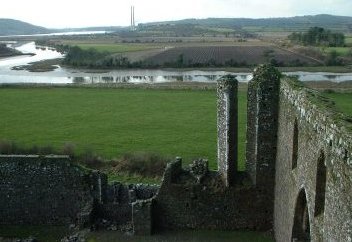
View showing River Pill and remains of West Window
|
|
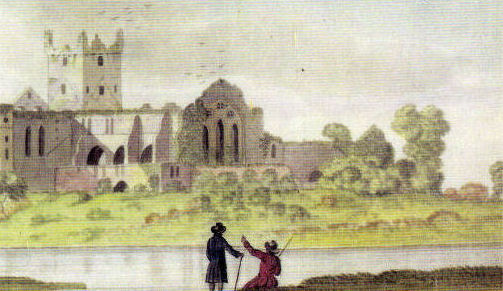
|
|
This
is a painting of Dunbrody Abbey by Gabriel Beranger from
around 1780. You can see the Great West Window which fell in
1852. The title is Dunbrawdy Abbey which is the correct
pronounciation. |
|

What abbey looked like originally
|
The
monks of Buildwas then gave the lands to St. Mary's of Dublin
and began the building of Dunbrody in 1182. They were
delighted with their new lands. The site
was ideal as it was
near where the local River Pill flows into the Barrow and was
surrounded by forests. The monks had good fishing and hunting
grounds. So they
had plenty salmon and venison and they also
collected tolls or taxes from people
using the river. The
Abbey was now known as the Port of St.Mary's as it offered
safety to people in trouble or on the run from their enemies.
It was dedicated to
the Blessed Virgin.
Hervey, even though married, became a monk in the Abbey.He
died there at the
age of 75 in 1205. His tomb and his statue,
which were near the high altar, were destroyed by soldiers
from Duncannon Fort in 1798.
In 1195 Pope Celestine placed the Abbey under the protection
of St.Peter and St.
Paul.
The townlands granted to Dunbrody were Curraghmore,Drillistown,Dunbrody,Coole,
Ballyhack,
Ballygow,Balystraw,Ballyvelig,Balliniry,Coleman,Clonsharragh,Haggard,
Boderan,Clonlard,Kilhile,Mersheen,Monachee,Nook,Ramsgrange,Duncannon,Balliniry,
Rosetown,Saltmills,Shielbaggan,Grange and Tinnock. They also got over
200 acres
in Great Island and some reclaimed land in Kilmannock.
There is a story of where the Abbot of Dunbrody and two of his
monks put a monk
from nearby Tintern Abbey in prison for three
days and robbed him of two horses
and money. There was trouble
between the two abbeys over what land each owned.
|
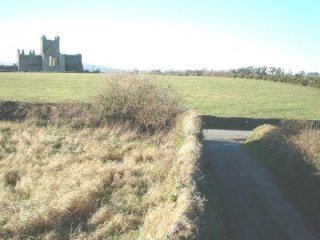
Boreen an Bháis with the Abbey in
the background
|
| This is
a picture of the lane which goes from Ballyvelig to
Dunbrody Castle. The story goes that a party of monks
were strolling along one evening saying their vespers or
evening prayers when they were attacked by some of the
native Irish. It is said that they were slaughtered and
the lane became known as Bóithrín a Bás or the Lane
of Slaughter. Some call it the Bloody Lane.It could
also because of a fierce battle fought here between the
Etchinghams and Chichesters over the abbey lands as the
Chichesters became owners through Jane Etchingham's
marriage to Arthur Chichester in 1660. |
|
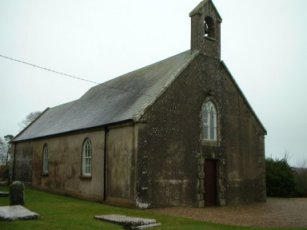 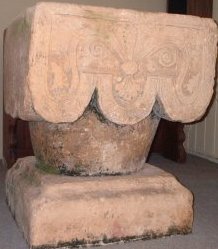
|
| St.Mogue's
Church of Ireland in Fethard and Baptismal Font from
Dunbrody Abbey |
The next important Abbot was Alexander Devereux. He knew that
the protestant
King Henry 8th was going to suppress or destroy
Dunbrody Abbey. He gave the lands to his brother. He then
changed his religion and became the first protestant Bishop
of
Ferns and went to live in Fethard-on-Sea closeby. Alexander
brought with him the baptismal font from the Abbey and this
font is still in use today in St.Mogue's Church. St.Mogue is
another name for St.Aidan the patron saint of Wexford. He was
the first catholic Bishop of Ferns. Alexander is buried in St.Mogues Church.
On the 6th may 1536 Henry 8th ordered Dunbrody Abbey to
be suppressed or banned.The abbey was plundered and
made unfit for any monks to come back and live there. All
valuables went to the king. The lead from the roof was melted
down and could be used to make ammunition. The wood from the
roof was used for fire in the smelting. Dunbrody Abbey was now bare and its religious life at an end. Alexander later
changed back to his Catholic religion before he died.
|
|
The
abbey was suppressed and the monks banned by the protestant
Henry VIII.
|
|
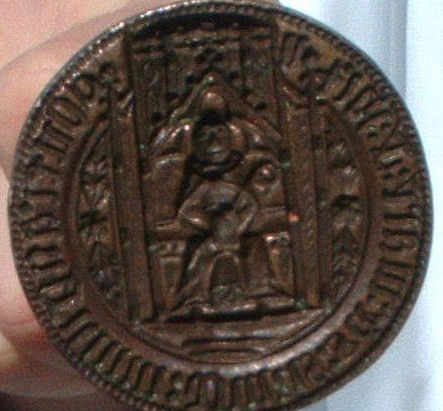
|
|
The bronze
Dunbrody Abbey seal was found in Kilhile Castle in 1852.It is
about 4cm wide. The abbot is sitting on a throne with a canopy
or covering over him. He has a crozier in his right hand and
his head is bare. Around the seal is written in Latin 'Contrasigilluim
Domus Sccs Marie de Portu' which means the seal of Saint Mary
of Refuge. Patrick Belfast,the Marquis of Donegal has the
seal. |
|

Drop in on our
lovely Dunbrody Abbey sometime.
|
|
Visit
the maze,castle and craft shop. |
And
the doll’s house. |

| Please remember
Dunbrody Abbey is a National Monument. Guided tours
are available and the abbey should be treated with
respect. Seán Crowley. |
Back
to Local History |
|
|

